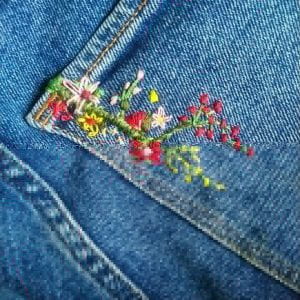Our Visible Mending online session took place yesterday (25th February), led by the talented Courtney Claunch from the Library and Learning Centre. In this blog post Courtney shares her experience with the art of visible mending and recommends some resources to get you started:
The idea of visible mending came to me during the first lock-down when I tore the pocket of my favourite jeans on a nail whilst gardening. A tear in your fav jeans is the equivalent of a little part of your soul being rent from your being. At least it is to me – it’s so hard to find good jeans, and these are the perfect jeans to work in: tough, durable and so comfortable. I had to try and repair them!
But I remembered the Japanese art form of Kintsugi, whereby a broken pot is repaired with a band of gold which follows the belief that a flaw can be beautiful – a sign of life and part of the story of the item. In this respect, I decided to embrace the tear in my jeans though hand embroidery techniques to embrace the imperfection and create art from it.
Visible mending is eschewing fast fashion and the idea of purchasing cheap replacements instead of taking care of your current possessions. It is welcoming both mistakes and the age of items through making them beautiful, full of self-expression and something that is uniquely ‘yours’. Instead of seeing clothes as disposable, visible mending values sustainability and suggests a different way of relating to them.
Mending has been around for as long as clothing has been worn by humans, but it is only recently that clothes have been considered a disposable commodity. Instead of hiding the rips and tears, visible mending turns them into a form of self. It is a fantastic first step to being aware of the quality of your clothing and moving away from cheap, fast fashion and toward a more sustainable way of living through acquiring and caring for a higher quality of garment. By establishing a relationship with the items you purchase, you can see them as extensions of yourself and as a means of personalisation. In this way, we reconnect with our goods and stop seeing them as readily expendable but as something to cherish for years to come.
Visible mending can also bring a community together through sharing tips and tricks. In Thursdays’ session, we had two amazing suggestions for visible mending – using a jar if you don’t have a darning mushroom (or if you are working on something such as a trouser leg or garment arm area) and if tailor’s chalk isn’t readily available, to use a dried sliver of soap, which marks the garment beautifully, and washes out without leaving any permanent marks and costs no more than the ends of the soap you are already using in the shower.
Mending can be done a number of ways, and the rule is: there are no rules! If it works for you, that’s all that matters. From darning mushrooms, to embroidery hoops, the way of mending is creative and has no limits to what you can achieve. From darning to embroidery, visible mending – or any kind of mending – is a way to make your clothes, furniture and household beautiful and new again at minimal cost.
Resources:
- Visible Mending.com
- Bel Jacobs – The art of visible mending
- Better Homes & Gardens – Visible Mending Is a Beautiful Way to Repair Your Clothes—Here are the Basics
- The Spruce Crafts – 10 ways to mend and repair clothes using embroidery
- Pinterest – Cape Codshibori – Visible Mending
- YouTube – Better Homes & Gardens – Learn The Basics of Visible Mending
- Kintsugi repair kit
More information about visible mending techniques can be found in the Courtney’s slides from the Visible Mending online session.
